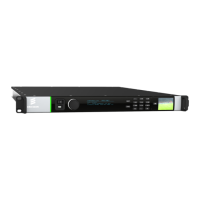Getting Started
Note: The unit can be configured to simultaneously provide either the same TS
over multiple outputs (e.g. where additional output option cards are fitted) or
different TS and the various available outputs. See section 3.8.9 for
information on copying a TS.
1. Navigate to the Service Configuration web page.
2. Expand the Host Outputs node in the Outputs widget, and click on the required
output. A blue box is drawn around the selected item and the properties
associated with it are displayed in the Transport Stream accordion panel of the
Properties widget.
Note: The Satellite Modulator Output Stream 1 and Satellite Modulator Output
Stream 2 outputs behave somewhat differently than the other outputs.
When selected, the parameters from the Device Configuration >
Advanced Video Processor Settings > Encode > Slot n – Satellite
Modulator Option Card > Satellite Modulator Option Card > Modulation
Parameters, Output Parameters and Input Parameters are shown to
ease access and reduce the time needed for setting up the unit. The Input
Parameters tab is shown to allow easy access to the RAS encryption
setting. All other parameters on this tab should be left at their default values.
For other outputs, an empty page is shown in the Properties widget if no
Transport Stream exists under them. Otherwise, the Transport Stream
properties are displayed.
3. Create a Transport Stream by right clicking on the required output and selecting
the Add Transport Stream command from the context menu, as shown in
Figure 3.5. The properties of the newly created Transport Stream appear in the
Properties widget.
Figure 3.5 Service Configuration Web Page – Adding a Transport Stream
4. Adjust the Transport Stream properties as required.

